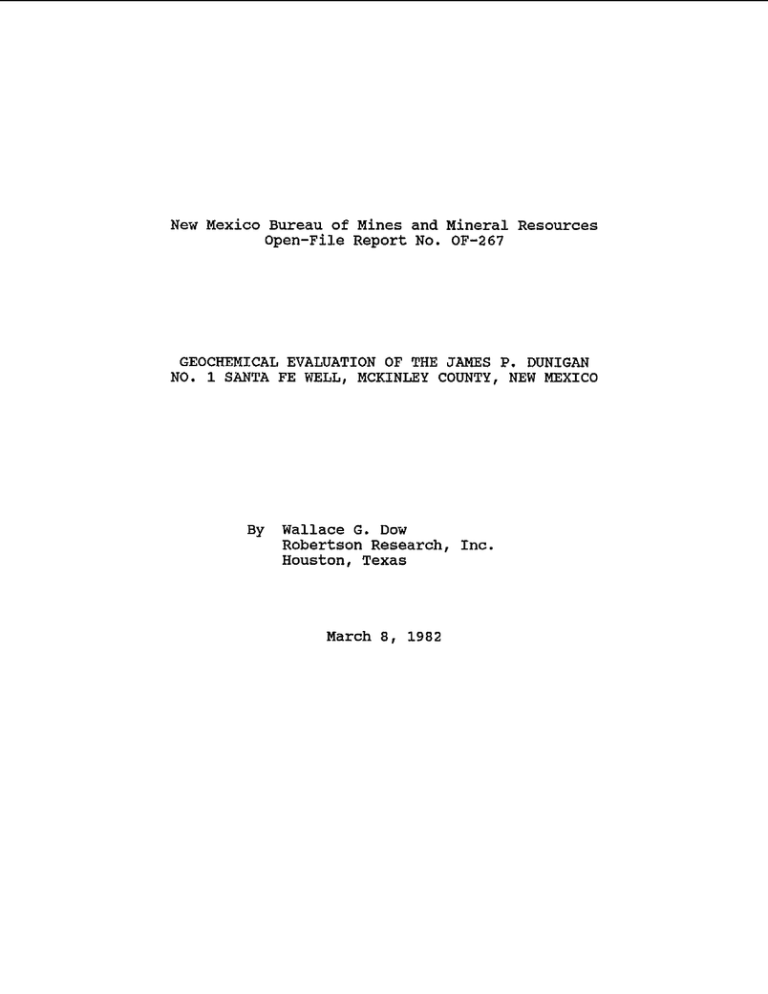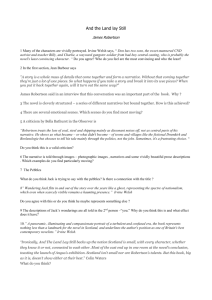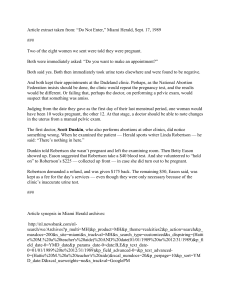P.
advertisement

New Mexico Bureau of Mines and Mineral Resources Open-File Report No. OF-267 GEOCAEMICAL EVALUATION OF THE JAMES P. DUNIGAN NO. 1 SANTA FE WELL, MCKINLEY COUNTY, NEW MEXICO By Wallace G. Dow Robertson Research, Inc. Houston, Texas March 8, 1982 a (U.S. 1 INC. ROBERTSON RESEARCH REPO-ST NO. 580 U" GEOCHEMICALEVALUATION OF THE JAMES P. DUNIGXN NO. 1 SXNTAFE, MCKINLEY COUNTY, NEW AtEXICO 3/"/9/d"U by Wallace G. Dow Project No. R R U S / 8 1 2 / I I / T / 1 2 7 UT Prepared by: RobertsonResearch ( U . S . ) Inc. 16730 Hedgecroft,Suite 30.6 Houston,Texas 77060-3697 Y Prepared for: Champlin Petroleun Company 5800 S. Quebec Englewood, Color~do 80111 ?,larch 8 , 1982 1 .Y ROBERTSON RESEAFCH [US.] INC. TABLEOF CONTENTS PAGE NO. 11. INTRODUCTION 111. DISCUSSION OrganicMatterConcentration KerogenType Kerogen Naturity IV. REFERENCES V. FIGURES 1. Organic Carbon and Visual Kerogen 2. Rock-Eva1 Pyrolysis Plots 3. Kerogen Type from Pyrolysis Data 4. Kerogen Maturation Profile 5. Zones of Oil and Gas Generation 6. Lithology Symbols '3 VI, APPENDICES I. Organic Carbon Data 11. Rock-Eva1 Pyrolysis Data 111, Vitrinite Reflectance Data 1 5 Plots 6 7 8 9 10 11 12 14 17 ROBERTSON RESEARCt-I [U.S.] INC. ... GeochemicsII da.ta on sampIdes from the James P. Dunigan, No. 1 Santa Fe well indicate ‘good tovery good sourcequalitythroughoutth?Cretaceoussectionandvery rocks.Thekerogenpresent low organiccarboncontents in all of the samplesanalyzed dry gas-generatingandterrestrialinorigin,but slightly a higher convertabilitytoliquidhydrocarbonsoccursinthe ceous section. The organic-rich Cretaceous shales are enoughforgasgenerationatthelocation .. in pre-Cretaceous is primarily lowermost Creta- of thesubject no: mature well, but oil could be generated below about 2,400 feet and preserved to about 7,200 feet.About 4,000 feet of erosionhasoccurredsince ma.dmum burial tookplace andhydrocarbongeneration is, therefore, no longe-active. Sourcebeddistributionandthe timing of hydrocarbongenerationare important variables which must be considered in any economic e-raluation of the area. I1 INTRODUCTION . Thirty-three very small bitcuttings samples from thesubject well were analyzedaccording to a programotitlinedbytheclient.Because of very low organic carbon contents in most pre-Cretaceous samples, RockEva1 pyrolysis could not be run and the number vitrinite reflectance was considerably reduced. of samples analyzed with Analyticaldataaretabulated in Appendices 1-111 andselectedparamerers are plotted on Figures 1-4. Age and lithology designations shown on thefiguresweretaken from a sample logsuppliedbythe client. Lithologysymbols used in generatingthecomputergraphicsare illustrated on Figure 6. -1- ROBERTSON RESEARCH [U.S.] INC. 111 DISCUSSION ' OrganicMatterConcentration Theorganiccontent of rocks is relatedtotheweightpercent carbontheycontain.Totalorganiccarbon is quitehigh Cretaceoussamplesanalyzed,dueprimarilytothepresence organic in moFt of the of coal. Most of the Cretaceous samples are rated as .good to very good PI source low inorganic quality(Figure 1). Pre-Cretaceoussamplesareallvery carbonandarerated as nonsourcesforproducableamounts of oil or gas. If thin, source quality intervals exist in the pre-Cretaceous section,theyhavebeenmaskedbydilutionwithorganic-leanmaterial. Even if this is true, the volume of any possiblesourcequalitysection '9 which may bepresentandthe amount of petroleum generated would be limited unless more favorable source facies are present in other portions of the basin. KerogenType Thetype of kerogenpresent,andhence its capability to generate oil o r g a s , w a s determined by Rock-Eval pyrolysis and by visual examination with reflectedlightmicroscopy. Both techniquesindicate a predominance of gas-generating, terrestrial organic matter in all of the samples analyzed. Poor source potential (data from pyrolysis S2 peak,Figure 2 1 , low hydrogenindexvalues(Figure 31, and low visual percentages of oil-generating amorphous and exinite organi? matter (Figure l), all are characteristic of low hydrogen, gas-generating kerogen, Somewhat more favorableconvertability to, oil define,lbythe . , 3 ) pyrolysis S2/S3 ratios (Figure 2) is believed to be due to solid bitumen in the samples (Appendix 111) and to unusually low oxygen index values (Figure 3). This ratio, therefore, is probably not a good kerogentypeindicatorforthesubjectsamples.Thebestpetroleum ROBERTSON RESEARCH [U.S.]lr\NC: )' , convertabjlity appears be to in lowermost Cretaceous samples 3 , 7 0 0 and 4,100 feet.Pennsylvanian Vetween samp'les were too low in organic contain primarilyterrestrialkerogen carbonforpyrolysisbut from v i s u a l analysis. KerogenMaturity Kerogen maturity was determinedwith Rock-Eval pyroIysis(T-max) vitrinite reflectance (Ro). Pyrolysis T-mas values are ne:lrly and all the same throughout the Cretaceoussectionandareveryclose to the top of theoil-generationzone(Figure 2 ) . Theapparentlack of maturity increase with depth nay be due to the presence of caving from the coal-rich interval near the top of the Cretaceous section. This is supported by the presence of low-rank vitrinite of uniform maturity in nearly all 'of theCretaceoussamplesanalyzed(Appendix tanceanalysis,however,alsorevealedthepresence vitrinite population in addition to the caving, and these Reflecof anindigenous da.ta were 111). used in constructing the maturation profile (Figure 4). In spite of contaminationproblems and poor qualitydata from most pre-Cretaceous samples, we believe the maturity profile to bereliable. zone (0.6-1.4 Ro) Figure 4 indicatesthattheoil-generationmaturity occursbetweenabout 2 , 3 5 6 and 7 , 1 6 4 feetandthatdrygas s'louldbe generated below about 5 , 2 5 6 feet (1.0 Ro). Crude oil could be preserved toabout 7 , 1 6 4 feetand wet gas/condensate could svrvive to 8,188 feet ( 2 . 0 Ro). Projection of the maturity profile to 0.2 Ro demonstratesthatabout 3 , 8 7 7 feet of sectionhasbeenlosttoerosion since maximum burial took place. Cooling associated with thi3 loss of overburden has caused hydrocarbon generation to become suspelded and anysourcebedspresent would not beacrivelygenerating oil o r gasat the present time. Expulsion, migration, and accumulation of hydrocarbons may have occurred during maximum burial but they would have had LO survive the period of uplift and erosion. Recently formed struc- -3 - ROBERTSON R E S E A R C ' i [U.S.) INC. '9 . tures, therefore, takenplace. may not contain petroleum unless remigrati3n has We recommend that a more detailedgeologlcal/geochedcd study of the basin be undertaken to more accurately define Source bed distribution,capacity,andthe tion,andaccumulation. time of hydrocarbongeneration,migra- -4- ROBERTSON RESEARCH [US.] INC. I V REFERENCES Clementz, D. M., 1979, Effect of oil andbitumensaturationassource rockpyrolysis: Dow, W. Bull., AAPG, vol. 63, pp. 2227-2232. Kerogen studies and geological interpretations: Jour. of Geochem. Expl., vol. 7 , pp. 79-99. G., 1977, of southerm San Juan Bal-Jin, New AAPG, vol. 64, p. 682 (abstract). Bryant, A. C . , 1980, Entradafields Xexico: Bull., Ross, L. M., 1980, Geochemical correlation of San Juan Basin oils study: Oil and Gas Journal, Nov. 3, pp. 102-110. - a Silver, C., 1968, Principles of gas occurrence, San Juan Barin: in Natu.ral Gases of North America: XAPG Memoir 9 , pp. 94e-960. -5- ROBERTSON RESEARC"I [ U S . ] INC. JAHES P DClNIGAN #I, SANTA FE t' L 3 - I . .. ,. .. .. .. .. .. 1. ! , I ; \ ; .... .. .. .. -.... ! .. .. .. ,.. I I I I : I . . I I"L FIFJRE I : SUWARYPLOTS SHOVING XE!?CGE?I TYPES,nATURITY, AND SOURCE ZiCHNE3S (SEE AFFE>IDiCES I AND i I I ) -6- ROBERTSON RESEARCH [U.S.] INC. JAMES ? DUNIGAN # I , SANTA FE " 1L- .- JAEES P OCNICAN I a00 ' H Y 800 f SANTA FE 81, IlOlL I 0 R -- c 630 N * N 4a0 -X 0 280 0 E 25 50 75 laa OXYGEN 125 150 : 75 200 INCEX FIGL'RE 3 ; KERCGEX TYPE OETSR!lINATICN PYROLYSIS G A T A FZatl i70CK-EVAL. (APPENOIX 111. -8- ROBERTSON \ ."" .""_ 1 L -"" ". -10- ROBERTSON RESEARG-I [U.S.) INC. LIST OF LITHOLOGY SYMBOL'S USED IN FIGURES I0 t GAP 220 : SNDY MRL 20 : CLY/CLYST 230 : MG LST 31 : HOST 240 : M6 OCL 41 : SH .- Ez 250 : SNDY LST 260 : SEmY OFL 50 : SLTST .x.:.>:.:. ::::::::::::: 61 ,$;;$;;2 , r @ E SST,fn J : ..... ..... ..... 62 : SST,ned 63 I SST,ers : ca+ .%?. ..." 70 " " 7IGURE: 280 : SLTY OK 291 I DOL LST : BRECCIA 292 : CALC 3OL 8 0 : CGL- 170 : SLTY CLYISTI 300 : Mri LST n m 180 t SNDY XYIST) 31I1 : ANH DCL 171 : SLTY SH 340 I I/B $ST/% 1st : SNDY SH 368 : I/B SST/liCJMST 360 : I/B SST/CLYST $0 E LST 161 ?E?.* - = 270 : Iaa : LST 110 : DOL 320 : CHK 820 : SHELL DEBRIS 120 : ANH -2:. @ 191 : SLTY XDST 201 I WY HDST 210 I SLTY M L -2 " 6 -11- ROBERTSON RESEARCH [US.] INC. T APPENDIX I . . TOTALORGANICCARBONDATA Total organiccarbon is determinedbypulverizingthesaaple,treating a carefully weighed portion with warn hydrochloric acid to remcve carbonateminerals,andanalysingtheresidue for carboncontent with a Leco carbonanalyser.It is generallyacceptedthatsamples with less thanabout 0 . 5 percent T O C cannot yield sufficient petroleumto form commercial depositsandarethereforeconsiderednonsources;samples with between 0 . 5 and 1.0 T O C are rated as marginal in source quality; and samples with more than 1.0 T O C are considered to be gocd in source quality. . . -12- ROBERTSON' RESEARC'i [US.] INC. TOTAL O R G A N I C C.G.~ON J A M E S P DUNICAN # 1 . " 'c DElTH (Feet') ._ W 11' DATA S X N T X E2 DEPTH (Feet) TOC (%) TO C (Yo> 535 92s 1375 1795 2185 1.10 1.27 2.29 2.31 1.03 6115 6655 7275 7525 7945 0.03 2655 2855 3165 3435 3745 0.93 0175 8215 8405 8525 8565 0.17 0.21 0.21 0.19 0. LO 2865 8615 0.11 Ed25 0.18 4145 457s 492s 1.79 1.27 1.87 0.14 0.06 a675 8795. a965 0.11 0.22 0 . 1 1 5145 5165 5305 4755 0 . 1 6 0.16 0.25 0.04 8955 0.18 0.10 0.10 4065 0.79 5.83 I . 73 I .5? 9055 9195 -13- 0.1c 0.0: 0.03 0 . 1 3 APPENDIX I1 ROCK-EV-AL PYROLYSIS DATA . .' Rock-Eval data are expressed as mglg of rockandinclude f o r basic parameters: 1) SI representsthequantity of freehydrocarbors present in therock and is roughlyanalogous to thesolventextractable portion of the organiamatter; 2) S 2 representsthequantity of hydrocarbonsreleasedbythekerogen in the sample duringpyrolysis; 3) S3 is relatedtothe amount of oxygenpresent in the kerogen; and 4) T-max, in "C, is the temperature at which the maximum rate of generation (of the S2 peak)occursand can beused as anestimate of thermal maturity. r '3 . In addition, the ratio S 2 / S 3 provides general a indicat'on of kerogenquality(type)andrevealswhether oil or gas are Likely to be S l / ( S l + S z ) , or the productivity index, is generated. The ratio an indication of therelative. amount of freehydrocarbons (in place or nigrated) present in the sample. Hydrogen and oxygen index vattes are in n g of hydrocarbons (S2 peak) or carbon dioxide ( S 3 peak) per gram of organiccarbon. \Yhen plottedagainsteachother on avan Krevelen-type diagram, information on kerogen type and maturity can be obtained. Data are interpreted in the following manner: Source Potential Petroleum Type - values - of 5 2 value of S 2 / S 3 Generation Zones - values of T-max : (2.5 : dry gas 2.5-5.0 >5.0 : wet gas : oil 1435 435-470 : : immature 450 + ProductivityIndex hydrocarbons. - high'values -14- poor (2.5 2.5-5.0 >5. 0 : marginal : good OS : gas of S l / ( S l + S 2 ) indicaterigrated ROBERTSON RESEARCH [US.) INC. .- .DEPTH ( F E E T ) 433 ... .- 2185 2455 2855 3145 3435 3745 3865 XOCK-EVAL PV?-!oLVSiS RAW DATA JAMES ? DUNICAN t i l . S A m A FE 51 S2 53 2.734 3.109 3.699 7.017 0.484 4 3 4 0 . 1 74 0. 7 7 4 0.161 0 03: 435 43 1 0 .0 8 8 435 2.005 2.803 a .287 0.180 0.103 0,082 0 ,093 0 . 1 1 7 435 434 429 433 436 0.16d 0.11a a . 084 433 432 434 0 :273 1 . 425 1.698 0.179 0 .a 1,03930 2. 7 3 52 . 7 1 2 3.394 0.328 01..340435 a . 297 0 .521 0.820 0, .3 93 48 7 11.283 2.737 3.285 0.409 0.180 0.l o a 1.010 a . 279 0 .4 3 6 0.572 0.325 0.328 2 . a28 2 . 4 0 2. 74 3 2 3 .s a 6 T-MAX 5 15 /2 (/ 54 13 + 5 2 ) 0.546 1 . 362 0.415 a5 .. 63 17 21 6.5?8 05 3. 23 76 7 5.614 0.404 -15- 8. 880 ROBERTSON RESEARCH [ U S . ] INC. H Y D R O G E N AND O X Y G E N INDICES FROM R O C K - E V X L P Y R O L Y S I S D A T A . WITd T O C D A T A JAMPS P D U N I C X N DEPTH ( F E E T )' #1. HYDROGEN INDEX (nq H C l q T O C ) S X N T XP 3 OXYGEN I H D 5 5 <ma CO21a T O G ) 44 43 535 92s 1375 3 .2 . TOC (96) 1.19 1.27 2.29 21 29 2.31 2185 2655 44 2855 3165 3435 3745 23 23 39 9.93 0.79 5.83 1.73 1795 3865 4065 4145 43 159 30 191 34 22 192 1.03 I .59 1.78 1.27 1.87 . . -16- ROBERTSON RESEARCI-I [US.] INC. XPPENDIX 111 REFLECTEDLIGHTLlICROSCOPY DATA A sample of groundrock is treated successively with hydrochlo-ic and hydrofluoric acids to concentrate the kerogen, freeze-dried, mounted in an epoxy plug,andpolished.Kerogentype is identified with the aid of blue light fluorescence. contains visualpercentageestiThevisualkerogenanalysisdatasheet mates of eachprinciplekerogen type, notes on vitrinitedesc-fption, and kerogen fluorescence data. Y a '9 -r Thehistograms show measuredreflectance values of allvitrinitepresent and on all material with the visual appearance of ritrinite. Shadedvalues are thoseusedtocalculatetheinterpretedvitrinite reflectancematurities.Unshadedvalues are interpretedtobe oxidized vitrinite, recycled vitrinite, or possibly misidentified material such as solid bitumen. pseudo-vitrinite, or semifusinite. Sometines the samplesanalpsedcontain no vitrinite or have an fnsufffcientnu-ber of readings to allow a reliable maturity determination to be made. Alternatematurirycalculations are possible on a few samples.Thehistograms we identified by a sequence number and depth or notation. W -17- ROBE=ITSON RESEARCH (U.S.] INC. .U *- ROB€RTSON RESEARCH (US.) INC. REFLECTED LIGHT VISUAL KEROGEN ANALYSIS ROBERTSON RESEARCH [US.] INC. JAnES P OUNIGAN 1 1 . 25 IO I c *0 2 4 i i SANTA FE OEPTH 2a . a3 R F 535.0 FT 163.1n L 0.41 0 . a.3 0.42 a.45 70.40 30.47 10.40 30.49 x0.40 70.51 =0 OEPTH 22[ F x 9 z . a FT 282.0 n Ro ZATURITY OROEREJ REFiECT.*NCE VAL'dES a r0.33 10.43 'I0.53 m . 3 4 78.43 :0.5a -19- ROBERTSON RESEARC'i [U.S.) INC. DEPTH 1375.0 FT 419.2 H = Ro flATURITY X 18.e~ e VALUES %AN 0.48 0.m a.48 ST0 DEV HEJ r A N XOCE a.45 HIS TOG RAP^ a-4 ca.11 JAttES P OUNIGAN *I. SANTA fE 25- 0 8 ro a[ 4 OEPTH F X 1795.0 FT 547.3 X = Ro tlA7URITY t -20 - , ROBERTSON RESEARC'I [US.) INC. 25 0 F jS! c 15[ R c 2185.0 FT 666.2 fl I E VALUES MEAN S T 0 OEV VED IAN nCOE CAVE ? I!. 2s.a0 0.44 0.05 0.44 0.45 I , !- a 1a I/' I 1 2 3 V I T R ! N i T E RE,?LECT.ANCE lFlANC3fl X I 4 OROERED ?EFCICTANCEVALSES= a.43.. a.48 a 48 a.43 a.44 a.49 a.44 0.50 a.40 a.45 a . 5 1 0 . 4 1 0.45 a.52 a.42 a.46 8.43 a.46 0.30 a.37 a.3; 8.39 J A ~ E SP OUNICAN 25- E I , SANTA Fi: IO 6 DEPTH -21- 2655.0 Fl mc.5 n ROBERTSON RESEARCH [U.S.] INC. JADES P CUNIGAN D l . SANTA FE IO 7 DEPTH 2855.0 FT 870.4 D := Ro DATURITY 8 VALUES nEAN ST0 DEV HEJIAN VOOE CAVE ? A . 0 ’ I N C s 5: a B. 7.00 0.70 0 . I0 0.73 0.75 [ k h - lI L . l 2 3 4 V I T R I N I T E REFLECTANCE IRANCOD X I m.36 0.46T0.84 0.46 a.94 a.46 0.58 1.a2 a.48 a.Ja ~ 0 . 5 3 1.a2 1.08 0.41 ra.st 1.26 E . 4 1 X0.68 0.42 x0.73 1.31 0.44 70.76 0.37 0.37 a.37 fl VALLES NAN L! ‘F- Si0 CAVE ? CEV nED I AN nOOE j 34. a0 0 . 5a 0.as 0.49 0.45 I OROEF(E0 ?Eil-ECTANCEVALUES: a.39 0.45 0.50 0.58 -22 - ROBERTSON RESEARCH [U.S.j INC. 25 C CAVE ? - GX:gAT[ON ? n VALUES nEAN STD JEV nEDIAN VCDE 27.80 0.61 0.23 0.51 a.45 OROERED REFLECTANCE VALUES: a.37 8.38 0.44 , . . a.44 0.44 0.46 I 4.46 a.48 0.48 0.85 0.a9 ' a . ~ a a.91 a.a2 a- . 5 .1 0.52 0.52 0.53 1.a7 1.67 1.14 . JAMES P DUNIGAN s1. SANTA FE ID 10 DEPTH 3745.0 FT 1141.8 n 0.43 T0.78 0.43 ra.78 3 44 T O . 80 -23- ROBERTSON RESEARCH [US.] INC. 25 S I: I t F 20\ 0 R 15\ E a.4a n VALUES PEIN S T 0 OEV 'rEJ I AN PCOE E CAVE 7 40 6.00 0 ' . 84 0.08 53.87 a.95 0.56 0.BE '3 20 0 F z = R oC A T U R I T Y k s VALUES nEIN CEV STi) ?Ei)iAN '3 r3.77 -24 - 13.m a.96 a. 1 4 a.83 a.75



